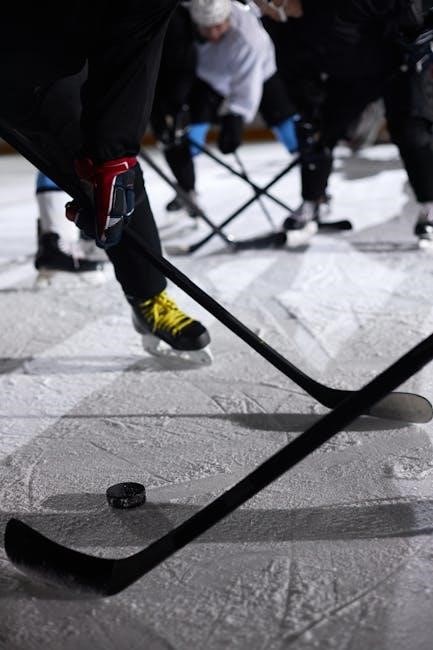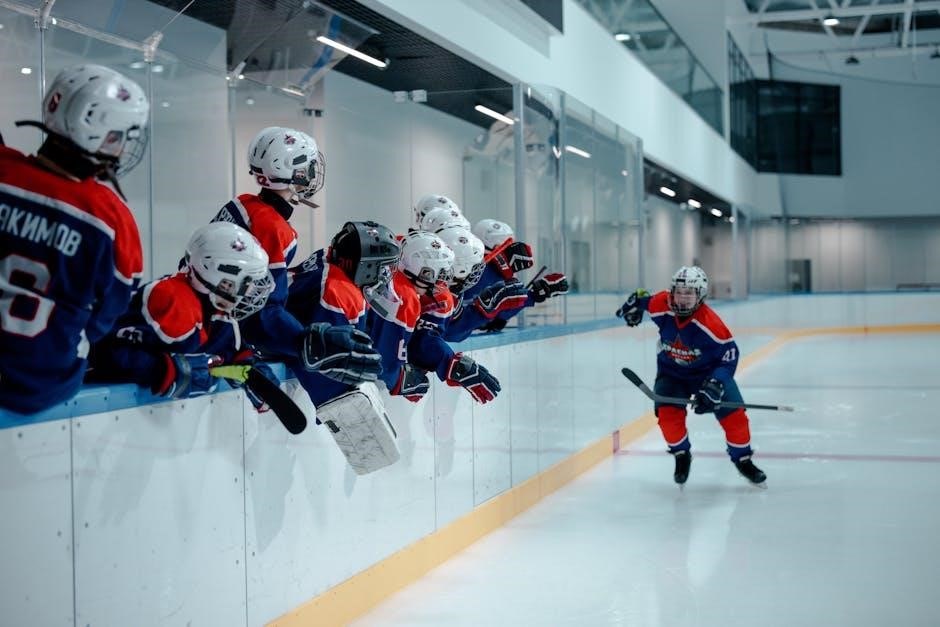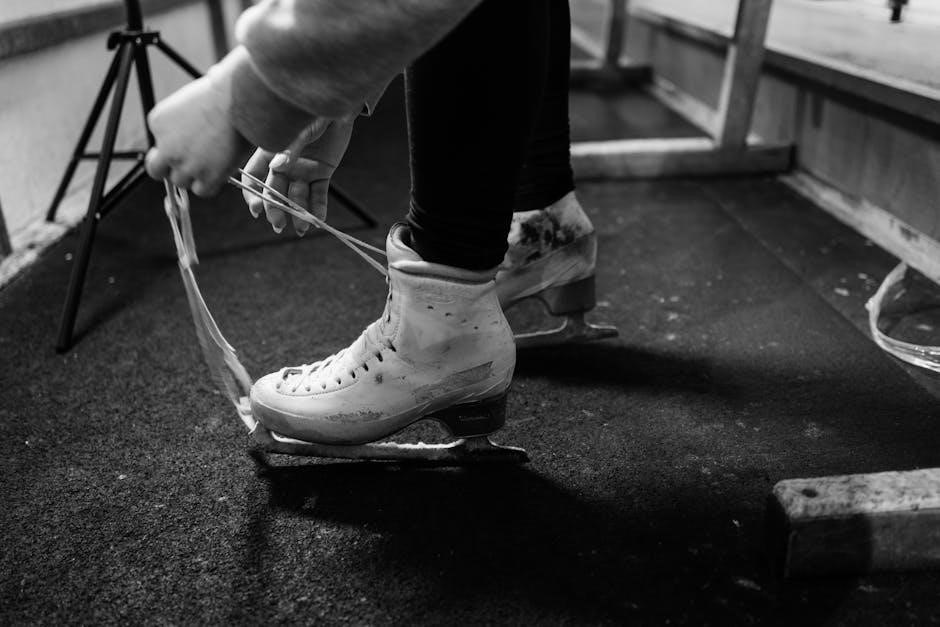
Understanding hockey skate sizing is crucial for optimal performance and comfort. Proper fit enhances skating efficiency, control, and overall enjoyment. This guide provides essential tips and insights to help you navigate skate sizing charts, measure your feet accurately, and choose the right size for your skill level and skating style. Whether you’re a beginner or an advanced player, finding the perfect fit is key to unlocking your full potential on the ice.
Understanding Skate Sizing Charts
Skate sizing charts vary by brand, offering size conversions and width options. They help match foot measurements to ideal skate sizes, ensuring proper fit and performance.
How Skate Sizing Compares to Shoe Sizing
Hockey skate sizing differs significantly from shoe sizing, as skates are designed for performance and support. Generally, senior hockey skates fit 1.5 sizes smaller than a men’s shoe size, while junior and youth skates fit 1 size down. This is because skates need to be snug to maximize control and efficiency on the ice. Proper fit ensures your toes barely touch the toe cap, allowing minimal movement from side to side but enough space to wiggle toes up and down. This tight fit is crucial for optimal skating performance and comfort, making accurate sizing essential for players of all levels.
Importance of Proper Fit for Performance
A proper fit in hockey skates is essential for maximizing performance, comfort, and control on the ice. Ill-fitting skates can lead to reduced skating efficiency, discomfort, and even hinder overall performance. Skates that are too tight can restrict movement and cause discomfort, while skates that are too loose may result in poor control and increased risk of blisters. A well-fitted skate allows for optimal energy transfer during strides and quick turns, enabling better speed and agility. Proper fit also ensures better support for the foot, reducing fatigue and enhancing overall skating performance. Whether you’re a beginner or an advanced player, achieving the right balance of snugness and comfort is key to unlocking your full potential on the ice.

Measuring Your Foot for Hockey Skates
Accurate foot measurement is vital for proper hockey skate sizing. Use a Brannock device or ruler to measure length and width while standing upright for precise fit.
How to Accurately Measure Foot Length and Width
To ensure accurate measurements, stand barefoot on a flat surface. Place your foot on a piece of paper, keeping your weight evenly distributed. Trace the outline of your foot carefully with a pencil. Measure the longest point (heel to toe) for length and the widest part across the ball for width. Use a ruler or Brannock device to record precise numbers. Always measure both feet, as they may differ slightly. For best results, measure later in the day, as feet tend to swell slightly. Accurate measurements ensure a proper fit, preventing discomfort and performance issues. This step is foundational for choosing the right hockey skate size.
Using a Brannock Device for Precise Measurements
A Brannock device is a reliable tool for measuring foot length and width accurately. To use it, place your bare foot on the device with your heel snug against the back. Slide the measuring slider forward until it touches the tip of your longest toe. This gives your foot length. For width, ensure the foot is centered and adjust the width gauge until it fits comfortably across the ball of the foot. Measure both feet, as they may differ slightly. Record the larger measurement to ensure a proper fit. Using a Brannock device ensures precision, which is essential for hockey skates, as even small discrepancies can affect performance and comfort. This method is highly recommended for accurate sizing.

Skate Width and Its Impact on Fit
Skate width significantly affects comfort and performance. Narrow, medium, and wide options cater to different foot shapes. Proper width ensures a snug, supportive fit, enhancing control and maneuverability.
Narrow, Medium, and Wide Skate Options
Hockey skates come in narrow, medium, and wide widths to accommodate different foot shapes. Narrow skates are ideal for slimmer feet, offering a snug fit that enhances control. Medium width is the most common, providing a balanced fit for average foot shapes. Wide skates are designed for broader feet, ensuring comfort and preventing blisters. Proper width is crucial for performance, as it affects how the skate hugs the foot. Choosing the right width ensures optimal support, stability, and mobility. Always consider your foot shape and try on skates if possible to determine the best fit for your needs.

How Skate Width Affects Skating Performance
Skate width significantly impacts skating performance by influencing fit, stability, and maneuverability. A skate that is too narrow can cause discomfort and restrict movement, while one that is too wide may reduce support and control. Proper width ensures even pressure distribution, allowing for better edge control and quicker turns. It also affects power transfer during strides, as a well-fitted skate maximizes energy efficiency. Skaters with wider feet may find wider skates enhance stability, while narrower feet benefit from a snug fit for precision. Ultimately, the right width balances comfort and performance, enabling skaters to perform at their best on the ice.

Senior vs. Junior Skate Sizing
Senior skates fit 1.5 sizes below shoe size, while junior skates fit 1.0 size down, ensuring proper support and performance for different age groups and foot sizes.
Differences in Fit for Adults and Youth
Senior hockey skates are designed for adults and full-grown teenagers, fitting 1.5 sizes smaller than shoe size for optimal support and performance. Youth skates, however, are sized 1.0 size down from shoe size, accommodating smaller, developing feet while allowing for growth. The fit differences ensure proper support and comfort for varying foot structures and skating demands. Adults require a snug fit for stability and control, while youth skates prioritize both support and room for growth. Understanding these distinctions helps in selecting the right skate size, ensuring comfort and performance for players of all ages and skill levels.
Recommended Size Reductions by Age Group
When sizing hockey skates, age plays a significant role in determining the ideal fit. Generally, senior skates fit 1.5 sizes smaller than shoe size, while junior and youth skates fit 1.0 size smaller. For younger players, such as those in the 8-12 age range, a slightly larger reduction may be necessary to accommodate growth. Teenagers nearing adult size often require less reduction, typically 1.0 to 1.5 sizes down. It’s essential to consult brand-specific sizing charts, as Bauer, CCM, and Graf may vary slightly. Proper size reduction ensures a snug, supportive fit, enhancing performance and comfort for players of all ages;
Brand-Specific Sizing Guides
Brand-specific sizing guides vary, with Bauer recommending 1.5 sizes down, CCM offering detailed charts, and Graf focusing on unique width systems for optimal fit.
Bauer Skate Sizing Chart
Bauer’s skate sizing chart is designed to help you find the perfect fit based on your shoe size. Generally, Bauer skates fit 1.5 sizes smaller than your regular shoe size. For example, if you wear a size 10 shoe, you would likely need a size 8.5 in Bauer skates. Their sizing chart provides a detailed conversion guide, ensuring accuracy for both senior and junior skates. Bauer also offers specific models with unique features, so it’s important to consult their official chart for exact measurements. Remember, proper fit is crucial for performance, so consider trying on skates before purchasing. Bauer’s sizing system is trusted by players worldwide for comfort and precision.
CCM Skate Sizing Chart
CCM’s skate sizing chart offers a precise guide to finding your ideal fit. Typically, CCM skates fit 1.5 sizes smaller than your regular shoe size, similar to other brands. For instance, a size 10 shoe corresponds to a size 8.5 skate. Their chart includes detailed measurements for both senior and junior skates, ensuring accuracy. CCM also provides specific sizing recommendations based on age groups, with youth skates fitting 1 size smaller than shoe size. They emphasize the importance of proper fit for performance, suggesting that skates should feel snug but allow slight toe movement. Always refer to CCM’s official chart for exact sizing, as variations may occur between models. Proper fit ensures maximum comfort and skating efficiency.
Graf Skate Sizing Chart
Graf’s skate sizing chart offers a unique approach to fit, focusing on precise width classifications. Unlike other brands, Graf uses a distinct method to categorize skate widths, ensuring a tailored fit for various foot shapes. Their sizing generally aligns with standard shoe sizes but may require adjustments based on individual foot dimensions. Graf skates are known for their durability and comfort, making them a popular choice for players seeking a snug yet responsive fit. Proper sizing is critical for performance, so consulting Graf’s official sizing chart is recommended. Always consider trying skates on if possible, as Graf’s sizing can vary slightly from other brands. This ensures optimal comfort and skating efficiency.

Skate Fit Tips for Different Skill Levels
Beginners should prioritize comfort and support, while advanced players opt for a snug fit to maximize performance. Proper fit varies by skill level to ensure optimal skating efficiency and control.
Beginner vs. Advanced Skate Fit Requirements
Beginners and advanced players have different needs when it comes to skate fit. Beginners often prioritize comfort and support, as they are still developing their skating skills. A slightly roomier fit can help prevent discomfort and blisters during long practice sessions. Advanced players, however, typically prefer a snugger fit to maximize performance, as it allows for better control and precision on the ice. The fit should adapt to the player’s skating style, frequency of play, and personal comfort preferences. Proper fit ensures optimal performance and prevents injuries, making it essential to tailor the fit to the player’s skill level and skating goals.
Professional Skate Fitting Recommendations
Professional skate fitters emphasize the importance of a precise fit to ensure peak performance and comfort. They recommend trying skates with thick hockey socks, as this mimics game conditions. A proper fit should allow toes to barely touch the toe cap, with minimal side-to-side movement. The heel should feel snug to prevent slipping during sharp turns. For advanced players, a tighter fit is often preferred for better control, while beginners may opt for a slightly roomier fit to avoid discomfort. Professionals also suggest considering the skate’s volume—narrower boots for slimmer feet and wider for broader feet. Heat molding is a recommended step to customize the fit further, ensuring optimal comfort and performance. This personalized approach ensures the skates adapt to the player’s needs, enhancing their overall skating experience.

How to Size Hockey Skates for Growth
Proper fit is crucial for growth. Allow a little extra room for toes to accommodate growth without sacrificing performance. Ensure skates are snug but not overly tight.
Tips for Buying Skates That Allow for Growth
When purchasing hockey skates for growing players, consider skates with a snug yet comfortable fit, allowing a little extra room for toes to accommodate growth. Choose skates with adjustable features or a slightly larger size to ensure they can be worn for multiple seasons. Measure foot length and width accurately, and consult brand-specific sizing charts for guidance. Ensure the skates are not too loose, as this can affect performance. Opt for skates with removable insoles to add extra space if needed. Proper fit ensures both comfort and performance, making it easier for young players to develop their skills on the ice.
When to Size Up for Junior Players
Junior hockey players often outgrow their skates quickly, so timing the move to a larger size is essential. If a player’s toes consistently touch the end of the skate or they experience discomfort, it’s time to size up. Growth spurts during the season may require intermediate adjustments. Typically, juniors should size up when their shoe size increases by a full size or more. Consult brand-specific sizing charts, like those from Bauer or CCM, for precise guidance. Proper fit ensures better performance and prevents blisters or restricted movement. Avoid sizing up too early, as overly large skates can hinder control and skating efficiency. Always try skates on before purchasing to confirm the fit.

Final Thoughts on Choosing the Right Skate Size
Selecting the right hockey skate size is a critical decision that impacts performance, comfort, and overall enjoyment of the game. Proper fit ensures better control, speed, and maneuverability on the ice. Always consider factors like foot length, width, and personal comfort when choosing a size. Refer to brand-specific sizing charts, as sizing can vary between manufacturers. Trying skates on before purchasing is highly recommended to confirm the fit. For junior players, account for growth, but avoid sizing up too early, as this can compromise performance. Remember, the right fit is an investment in your game, so take the time to get it just right.